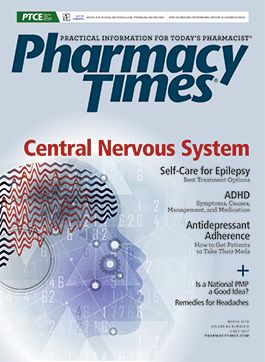Publication
Article
Pharmacy Times
Case Studies (March 2018)
Author(s):
What should these pharmacists do?
CASE 1
A father comes in to your pharmacy with a prescription for 250 mg of levofloxacin twice daily for 10 days for his 13-year-old son AV who has been complaining of facial pressure, nasal congestion, and rhinorrhea for the past 10 days. After outpatient observation without improvement, AV’s pediatrician diagnosed him with bacterial sinusitis. Taking a look at AV’s profile, you note that he has a non-type 1 allergy to penicillin. According to his chart, AV weighs 110 lb (50 kg), takes no other medications, and has no known drug allergies.
As the pharmacist, do you believe this is an appropriate drug regimen? If not, what would be your recommendation?
CASE 2
IB, a 38-year-old female and one of your regular patients, comes in to pick up her refill of Tivicay (dolutegravir) and Truvada (emtricitabine/tenofovir). While talking with her, you notice that her tongue seems to be abnormally white. You have IB come to the consultation window so you can examine her mouth, where you see that she has a large plaque-like lesion on her tongue. IB informs you that she noticed the lesion a few days ago, but says that she has not sought treatment because it is not painful. IB was diagnosed with HIV 4 years ago, but has no other conditions, does not take any other medications, and has no known drug allergies.
As the pharmacist, what would you suggest to IB?
SEE THE ANSWERS ON PAGE 2. ANSWERS
Case 1: Acute bacterial rhinosinusitis, or sinusitis, is an infection of the paranasal sinuses that can last up to 4 weeks. According to the Infectious Diseases Society of America (IDSA), first-line treatment is amoxicillin/clavulanate (Augmentin), which would not be an appropriate therapy due to AV’s penicillin allergy. For children with a history of a non-type 1 penicillin allergy, IDSA recommends a combination therapy of clindamycin (30-40 mg/kg by mouth 3 times daily) plus a third-generation cephalosporin, such as cefixime (8 mg/kg by mouth 2 times daily) or cefpodoxime (10 mg/kg by mouth 2 times daily). Levofloxacin, a respiratory fluoroquinolone, is reserved for use in children with a type 1 hypersensitivity to penicillin or a severe infection requiring hospitalization. Additionally, in July 2016, the FDA released an advisory against using fluoroquinolones as first-line therapy for uncomplicated infections, citing how their use is associated with serious adverse events involving tendons, muscles, joints, nerves, and the central nervous system. As the pharmacist, you should call AV’s pediatrician and request a therapy change from levofloxacin to clindamycin (30-40 mg/kg by mouth 3 times daily) and either cefixime (8 mg/kg/day by mouth 2 times daily) or cefpodoxime (10 mg/kg/day by mouth 2 times daily).
Case 2: Oropharyngeal thrush, also known as oropharyngeal candidiasis, is a common Candida infection in patients who have HIV. Candida is a yeast that usually lives on the skin or on the mucous membranes in small amounts but generally does not cause oral or vaginal yeast infections; however, it can multiply as a result of environmental disturbances, leading to overgrowth and candidiasis. Candidiasis is commonly caused by a compromised immune system and/or medications, such as cancer treatments or corticosteroids. In patients who have HIV, Candida acts as an opportunistic infection. The most common symptom of oral thrush is white slightly raised lesions in the mouth that can become painful, even spread into the esophagus in severe cases. According to IDSA guidelines, a mild infection can be treated with clotrimazole troches (10 mg 5 times daily) or a miconazole mucoadhesive buccal tablet (50 mg applied to the mucosal surface over canine fossa) for 7 to 14 days. For moderate to severe oral thrush, IDSA recommends 100 to 200 mg of fluconazole daily for 7 to 14 days. It is likely that IB has developed a case of mild oral candidiasis. As the pharmacist, after IB recieves a diagnosis from her physician, you should recommend treatment with clotrimazole troches (10 mg 5 times daily). Once her infection has been treated, preventative measures should be discussed. Although primary prophylaxis is not recommended, patients should be counseled to maintain good oral hygiene.
Mr. Ali is a PharmD candidate from the University of Saint Joseph School of Pharmacy in Hartford, Connecticut. Dr. Kohn is an assistant professor at the University of Saint Joseph School of Pharmacy in Hartford, Connecticut. Dr. Coleman is a professor at the University of Connecticut School of Pharmacy in Storrs, Connecticut.







